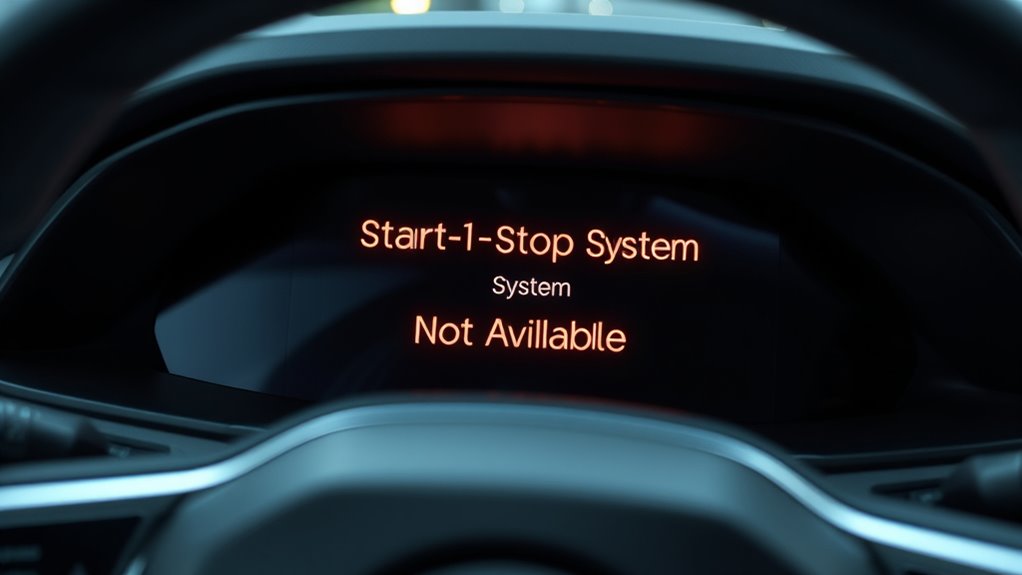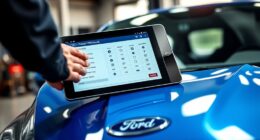When your Start-Stop system isn’t available, it’s often due to issues like a weak or dead battery, which prevents proper operation. Cold engines or extreme temperatures can also disable it, as can high A/C or defrost use. Sensor problems, such as dirty or damaged wheel speed or brake sensors, are common causes too. Sometimes, software glitches or incorrect settings prevent activation. Understanding these factors can help you troubleshoot the problem effectively as you discover additional ways to resolve it.
Key Takeaways
- A weak or dead battery can disable the Start-Stop system, preventing it from being available.
- Extreme temperatures or high electrical demand may deactivate the system for safety and comfort reasons.
- Malfunctioning or dirty sensors, such as wheel speed or brake sensors, can cause system unavailability.
- Software glitches or recent updates might disable or interfere with the system’s operation.
- Incorrect vehicle settings or system disabled via controls could lead to the feature being unavailable.

If your vehicle displays a “Start-Stop System Not Available” warning, it means the system responsible for automatically shutting off and restarting your engine to save fuel isn’t functioning properly. This feature is designed to turn off your engine when you’re stopped, like at traffic lights, and restart it when you press the accelerator or release the brake. When it’s unavailable, it could be due to several common reasons, and understanding them helps you troubleshoot the issue effectively.
One of the most frequent causes is a low or dead battery. Your Start-Stop system relies heavily on a healthy battery because it needs to restart the engine quickly and efficiently. If your battery is weak or aging, the system detects this and disables itself to prevent stalling or starting problems. You might notice other signs of a failing battery, such as dimming headlights or slow electrical responses. Replacing or recharging the battery often resolves this issue, restoring the system’s functionality.
Another common reason is that certain operating conditions aren’t met. For instance, your vehicle might require the engine to reach a specific temperature before the system activates. If the engine is still cold, or if the cabin temperature is too high or low, the system may stay disabled for comfort and safety reasons. Additionally, if the air conditioning or defrost system is running at high power, the system might turn off to maintain performance or prevent excessive strain on the engine.
Ensuring your vehicle is warmed up and that comfort systems are within normal operating ranges can help the Start-Stop system function properly.
Your vehicle’s sensors also play an essential role. If sensors related to wheel speed, brake pedal position, or engine temperature are dirty, damaged, or malfunctioning, they can prevent the system from activating. For example, if the brake pedal sensor isn’t working correctly, the system might think you’re still moving or that conditions aren’t safe for stopping the engine.
Regular maintenance and sensor checks can identify and fix these issues before they disable the system.
Lastly, some vehicle settings or software glitches might cause this warning. If you recently had repairs or updates, a software bug could disable the feature. Checking your vehicle’s settings to ensure the Start-Stop system is enabled and updating your vehicle’s software through a dealership or service center might be necessary. Understanding vehicle dynamics and how sensors, battery health, and software interact can help you better diagnose and prevent issues with the system.
Sometimes, a simple reset or software update restores normal operation.
Frequently Asked Questions
Can the Start-Stop System Be Manually Disabled?
Yes, you can usually manually disable the start-stop system, but it depends on your vehicle. Many cars have a dedicated button, often near the gear shift or on the dashboard, allowing you to turn the system off temporarily.
Keep in mind, some vehicles revert to the default setting after restarting. Check your owner’s manual for specific instructions, as disabling the system may affect your vehicle’s efficiency and emissions.
Does Weather Affect the Start-Stop System’s Availability?
You might notice the start-stop system takes a little longer to work or isn’t available in certain weather. Cold temperatures can make the system cautious, like a cautious traveler avoiding icy paths, by temporarily disabling itself.
Excessive heat or heavy rain can also trigger this. It’s like your car’s way of protecting itself, ensuring peak performance and longevity, especially when weather conditions are less than ideal.
How Long Does It Take to Reset the System?
It usually takes a few seconds to a minute for your start-stop system to reset after turning off the engine or addressing an issue.
You might notice the system becomes available again once you restart your vehicle or resolve any underlying problems.
To speed up the process, verify your battery is in good condition, and check for any warning lights or error messages that could delay the reset.
Is There a Way to Update the System Software?
Yes, you can update the system software. Check your vehicle’s manual or visit the manufacturer’s website for instructions.
Many automakers offer over-the-air updates or require a visit to the dealership for a software upgrade. Confirm your vehicle is connected to a reliable power source and follow the provided steps carefully.
Updating the software can fix bugs, improve performance, and sometimes restore the Start-Stop system’s availability.
What Are the Safety Implications of System Failure?
If your start-stop system fails, you might experience reduced fuel efficiency and increased emissions.
However, your vehicle’s core functions should remain safe.
The system’s failure won’t affect essential safety features like brakes or airbags.
Still, it’s important to have it checked promptly, as repeated failures could indicate underlying issues that might compromise overall vehicle performance or convenience.
Always consult your vehicle manual or a professional mechanic for guidance.
Conclusion
When your start-stop system whispers “not available,” it’s like a symphony missing a crucial note. Sometimes, simple issues like low battery or faulty sensors act as the silent culprits, disrupting the harmony. By addressing these common causes, you can restore your vehicle’s rhythm and let the system sing once more. Think of it as tuning an instrument—you hold the power to bring back its full, vibrant performance.









